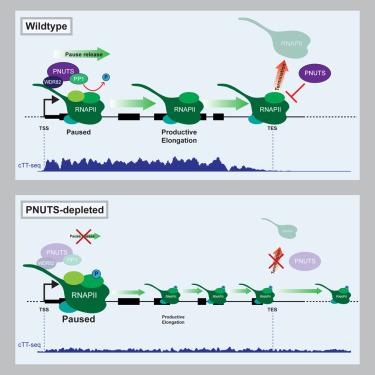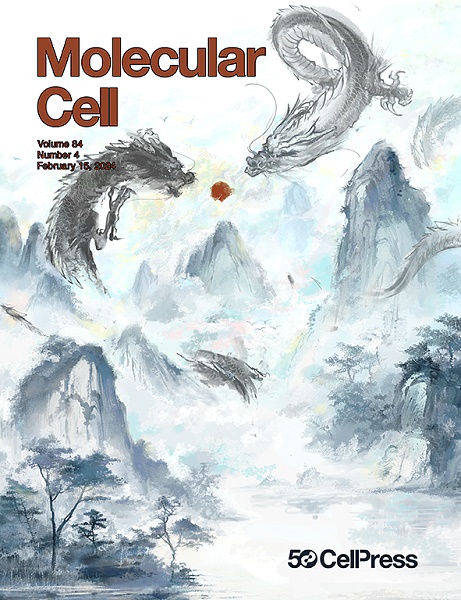The PNUTS phosphatase complex controls transcription pause release
IF 14.5
1区 生物学
Q1 BIOCHEMISTRY & MOLECULAR BIOLOGY
引用次数: 0
Abstract
Gene expression is regulated by controlling distinct steps of the transcriptional cycle, including initiation, pausing, elongation, and termination. Kinases phosphorylate RNA polymerase II (RNA Pol II) and associated factors to control transitions between these steps and to act as central gene regulatory nodes. Similarly, phosphatases that dephosphorylate these components are emerging as important regulators of transcription, although their roles remain less well understood. Here, we discover that the mouse PNUTS-PP1 phosphatase complex plays an essential role in controlling transcription pause release in addition to its previously described function in transcription termination. Transcription pause release by the PNUTS complex is essential for almost all RNA Pol II-dependent gene transcription, relies on its PP1 phosphatase subunit, and controls the phosphorylation of factors required for pause release and elongation. Together, these observations reveal an essential new role for a phosphatase complex in transcription pause release and show that the PNUTS complex is essential for RNA Pol II-dependent transcription.

PNUTS 磷酸酶复合体控制转录暂停释放
基因表达是通过控制转录周期的不同步骤来调控的,包括启动、暂停、延伸和终止。激酶使 RNA 聚合酶 II(RNA Pol II)和相关因子磷酸化,以控制这些步骤之间的转换,并充当基因调控的中心节点。同样,使这些成分去磷酸化的磷酸酶正在成为转录的重要调控因子,尽管它们的作用还不太清楚。在这里,我们发现小鼠 PNUTS-PP1 磷酸酶复合物除了先前描述的转录终止功能外,还在控制转录暂停释放方面发挥着重要作用。PNUTS 复合物的转录暂停释放对于几乎所有依赖 RNA Pol II 的基因转录都是必不可少的,它依赖于 PP1 磷酸酶亚基,并控制暂停释放和延伸所需的因子的磷酸化。这些观察结果共同揭示了磷酸酶复合物在转录暂停释放中的重要新作用,并表明 PNUTS 复合物对 RNA Pol II 依赖性转录至关重要。
本文章由计算机程序翻译,如有差异,请以英文原文为准。
求助全文
约1分钟内获得全文
求助全文
来源期刊

Molecular Cell
生物-生化与分子生物学
CiteScore
26.00
自引率
3.80%
发文量
389
审稿时长
1 months
期刊介绍:
Molecular Cell is a companion to Cell, the leading journal of biology and the highest-impact journal in the world. Launched in December 1997 and published monthly. Molecular Cell is dedicated to publishing cutting-edge research in molecular biology, focusing on fundamental cellular processes. The journal encompasses a wide range of topics, including DNA replication, recombination, and repair; Chromatin biology and genome organization; Transcription; RNA processing and decay; Non-coding RNA function; Translation; Protein folding, modification, and quality control; Signal transduction pathways; Cell cycle and checkpoints; Cell death; Autophagy; Metabolism.
 求助内容:
求助内容: 应助结果提醒方式:
应助结果提醒方式:


